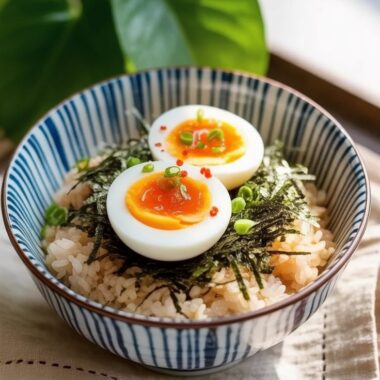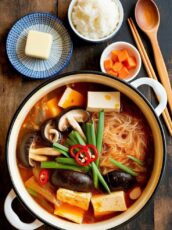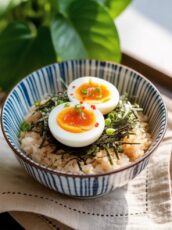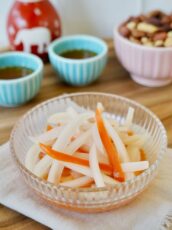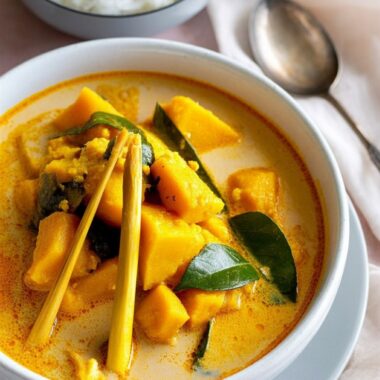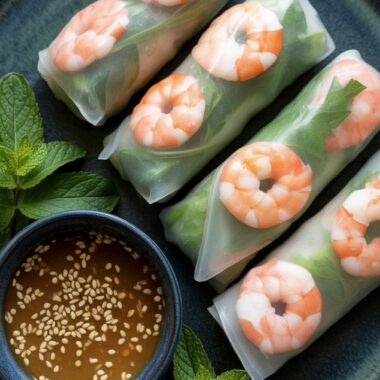There are some dishes that don’t just feed your stomach — they ground you. For me, doenjang jjigae is one of those. This Korean soybean paste stew is bold, brothy, and feels like a warm hug on a cold day. It’s what I make when I want something cozy, a little punchy, and still veggie-packed.

Let me walk you through how I make mine at home — the way I like it, with a few tweaks and tricks I’ve picked up after many bubbling pots.
What’s So Special About This Stew
At its heart, doenjang jjigae is a simple stew — built on doenjang (fermented soybean paste), rice water, tofu, and veggies. But like any good comfort food, every household has its own way of doing it.
Some make it with seafood, some go vegetarian. Mine? I love a beefy base — especially with brisket or fatty slices that melt into the broth. It’s hearty and filling but still feels clean.
A few other things make this version stand out:
- Rice water instead of anchovy broth: Not only is it easier, but it gives the stew a slightly sweet, starchy backbone.
- A spoon of ssamjang: This is a game-changer. Just a little adds this deep umami and spice that makes the whole pot taste like it came out of a Korean grandma’s kitchen.
- Gochugaru: I like a bit of heat, but you can skip this if you’re cooking for kids or spice-shy folks.
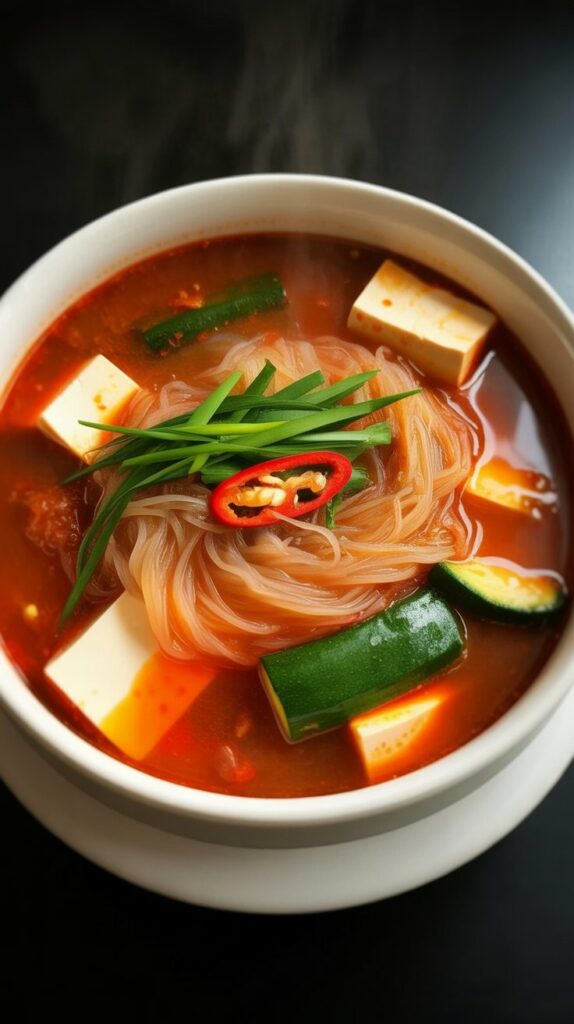
A Few Ingredient Tips Before You Start
Let’s talk details, because the little things make a difference here.
- Beef cuts: If you’re using brisket or fatty slices like chadolbagi, go for ones with good marbling. Too lean and they turn chewy. If you trim off the excess fat like I do, just add a bit more meat to keep the flavor rich.
- Rice water: Don’t throw it out when rinsing rice! That cloudy water (especially the second or third rinse) gives the broth a subtle thickness and extra depth.
- Doenjang and ssamjang: You’ll find both at any Korean grocery store. Use a sieve when adding them to the stew so they dissolve smoothly — no chunky bits floating around.
- Mushrooms: Enoki and shiitake give that earthy backbone. I always try to include both.
- Tofu: Use medium-firm so it holds its shape. I cut them into chunky rectangles so they soak up the broth without falling apart.
What You’ll Need
- 160g beef brisket, thinly sliced, bite-sized
- 2 tbsp rice wine (mirim)
- Fresh cracked black pepper
- 3.5 cups rice water (from rinsing rice)
- 3 tbsp doenjang (fermented soybean paste)
- 1 tbsp ssamjang (Korean spicy dipping sauce)
- 2 tsp gochugaru (Korean chili flakes)
- 1 tsp minced garlic
- 100g potato, thinly sliced
- 90g zucchini, thinly sliced
- 35g onion, thinly sliced
- 100g enoki mushrooms, stems removed and separated
- 45g shiitake mushrooms, thinly sliced
- 250g tofu, sliced into medium rectangles
- 20g green onion, thinly sliced
- 2–3 chilies, optional, for extra heat
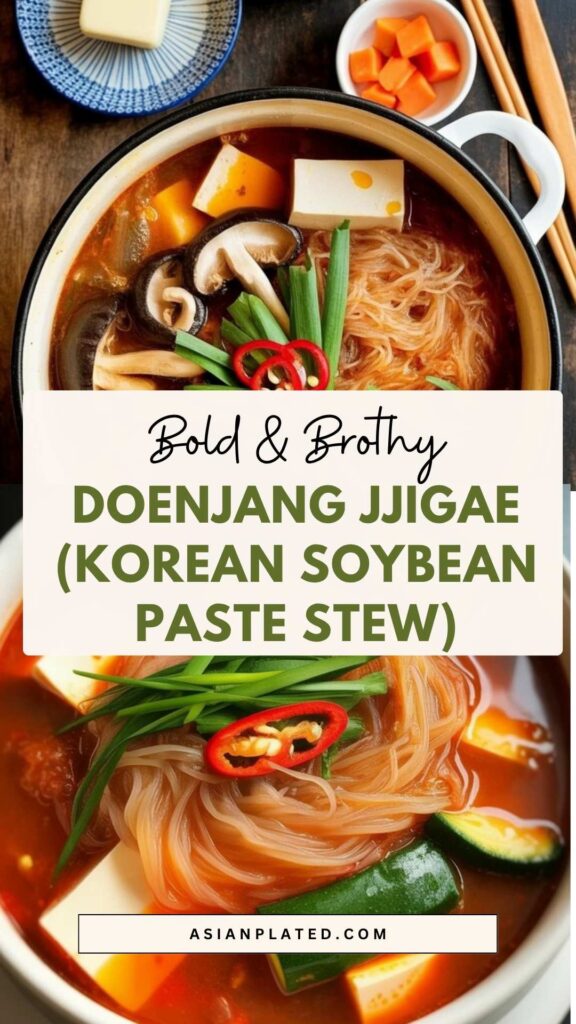
How I Make It – Step by Step
1. Prep the meat and start the pot
Mix the beef with the rice wine and a few cracks of black pepper. Let it sit while your pot heats up. Then toss in the beef — no oil needed if there’s a bit of fat — and stir it around until it browns slightly. Once it starts releasing that savory smell, toss in the sliced potatoes. Cook for about 2 minutes to let them get a little color.
2. Build the broth
Pour in the rice water. Now comes the flavor base — press doenjang and ssamjang through a fine sieve into the pot. Stir well so everything blends nicely. Add gochugaru and garlic. Give it all a good mix.
3. Load it up
Once your stew starts boiling gently, add the zucchini and onion. After a minute, toss in the mushrooms and tofu. Let that simmer for another minute or so. Finish by adding green onions and chilies (if using), and boil one last minute. Then take it off the heat.
4. Serve and enjoy
This is best served hot with a bowl of steamed rice and a few simple Korean sides. I love mine with kimchi, a rolled egg omelet, or a seasoned seaweed salad. Something salty and crunchy to go with the soft tofu and beef.
Serving Ideas From My Table
This stew is built for sharing. When I serve this to friends, I bring it right to the table in the same pot — hot, bubbling, and deeply fragrant. Everyone gets a bowl of rice and we just ladle into it.
It also works great for solo meals. Make a batch, portion it out, and reheat throughout the week. I’ve even thrown leftovers into a rice bowl with a fried egg on top — trust me, that’s next-level comfort.
Storing Leftovers
- Fridge: Keep it in an airtight container and it’ll last 3 to 4 days. The flavor deepens as it sits, kind of like a good curry.
- Freezer: I don’t usually freeze it because tofu gets a bit weird in texture. But the broth and meat freeze fine if you want to make a base and add fresh veggies and tofu later.
Doenjang Jjigae (Korean Soybean Paste Stew)
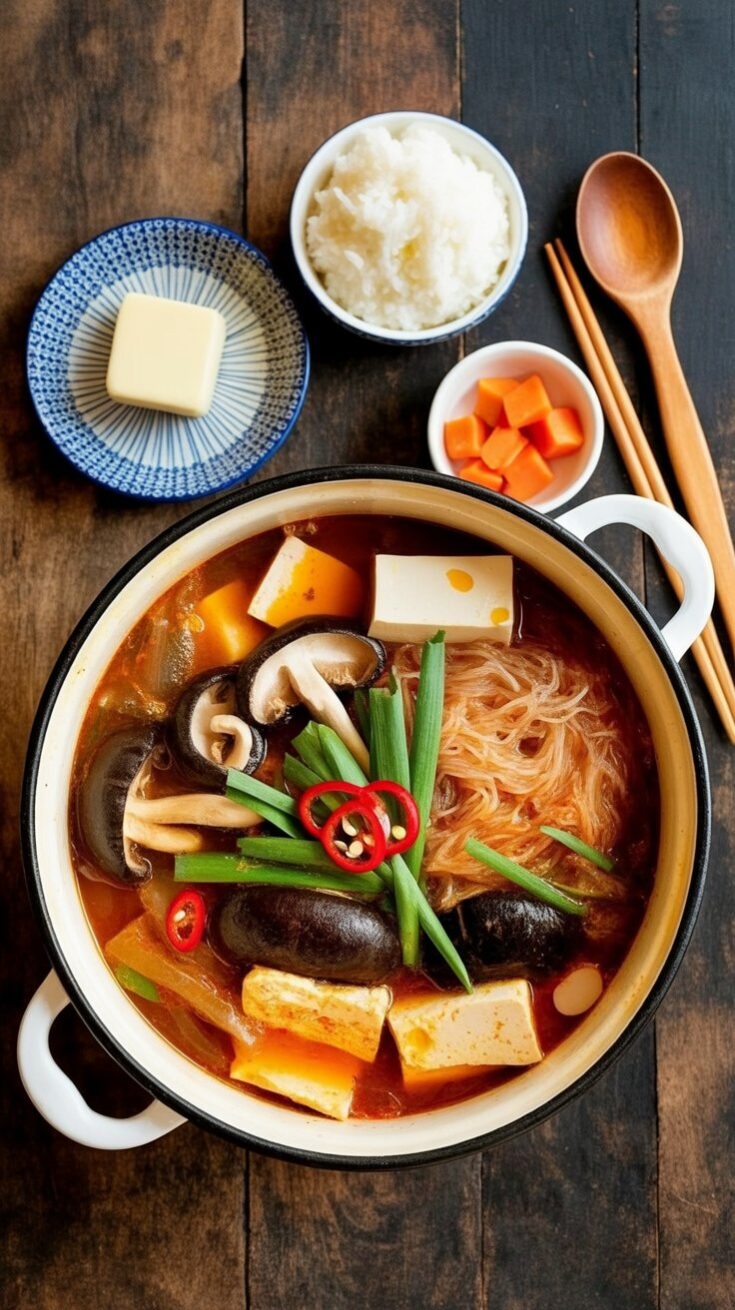
If you're craving something hearty, comforting, and deeply flavorful, this Korean soybean paste stew hits the spot.
Ingredients
- 250g tofu (about 8.8 oz), sliced into medium rectangles
- 160g thinly sliced beef brisket (5.6 oz), cut into bite-sized pieces
- 100g enoki mushrooms (3.5 oz), ends trimmed and separated
- 90g zucchini (3.1 oz), thinly sliced
- 100g potato (3.5 oz), thinly sliced (use an all-purpose variety)
- 45g shiitake mushrooms (1.5 oz), thinly sliced
- 35g onion (1.2 oz), thinly sliced
- 20g green onions (0.7 oz), sliced
- 2–3 red and green chilies (optional), thinly sliced
- 3.5 cups rice water (from rinsing rice)
- 2 Tbsp rice wine (mirim)
- 3 Tbsp doenjang (Korean soybean paste)
- 1 Tbsp ssamjang (Korean spicy dipping sauce)
- 2 tsp gochugaru (Korean chili flakes)
- 1 tsp minced garlic
- A few cracks of black pepper
Instructions
- Start by tossing the sliced beef with rice wine and a few grinds of black pepper in a bowl. Let that sit while you heat up a medium pot over medium-high heat. Once hot, add the beef directly—no oil needed if there’s fat on the meat—and stir it around until it starts to brown. Toss in the potato slices and cook them with the beef for a couple of minutes to soak up the flavor.
- Pour in the rice water and bring everything to a gentle boil. To infuse the broth properly, dissolve the doenjang and ssamjang through a small sieve into the pot. This makes it easier to break down the paste evenly. Add the gochugaru and garlic and give it all a stir.
- As soon as the stew begins to boil steadily, add the zucchini and onions. Let that simmer for about a minute, then gently place in the enoki mushrooms, shiitake mushrooms, and tofu. Simmer for another minute. Lastly, toss in the green onions and chili slices and let everything bubble for one more minute before taking it off the heat.
Notes
- Start by tossing the sliced beef with rice wine and a few grinds of black pepper in a bowl. Let that sit while you heat up a medium pot over medium-high heat. Once hot, add the beef directly—no oil needed if there’s fat on the meat—and stir it around until it starts to brown. Toss in the potato slices and cook them with the beef for a couple of minutes to soak up the flavor.
- Pour in the rice water and bring everything to a gentle boil. To infuse the broth properly, dissolve the doenjang and ssamjang through a small sieve into the pot. This makes it easier to break down the paste evenly. Add the gochugaru and garlic and give it all a stir.
- As soon as the stew begins to boil steadily, add the zucchini and onions. Let that simmer for about a minute, then gently place in the enoki mushrooms, shiitake mushrooms, and tofu. Simmer for another minute. Lastly, toss in the green onions and chili slices and let everything bubble for one more minute before taking it off the heat.
Nutrition Information:
Yield: 4 Serving Size: 1Amount Per Serving: Calories: 519Total Fat: 13gSaturated Fat: 4gTrans Fat: 0gUnsaturated Fat: 7gCholesterol: 42mgSodium: 132mgCarbohydrates: 76gFiber: 7gSugar: 16gProtein: 29g
Asianplated.com, occasionally offers nutritional information for recipes contained on this site. This information is provided as a courtesy and is an estimate only. This information comes from online calculators. Although allchickenrecipes.com attempts to provide accurate nutritional information, these figures are only estimates.
Quick Q&A
Can I make this vegetarian?
Absolutely. Skip the beef and use mushroom stock or vegetable broth. Add more mushrooms or even Korean radish for depth.
Is ssamjang really necessary?
No — but it adds a punch. If you like stronger, restaurant-style flavors, add it. If you prefer milder stews, just stick to doenjang.
What kind of tofu should I use?
Medium or medium-firm tofu works best here. Silken tofu will break apart too easily.
Can I make this in advance?
Yes! In fact, it’s even better the next day. Just reheat gently on the stove.
Let me know if you give this a try — or if you grew up with a different version. I love hearing how others tweak it to make it their own. That’s the beauty of dishes like this — they’re built on memory, but flexible enough to become your own.
Try other Korean recipes:

